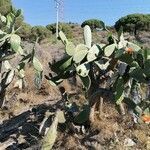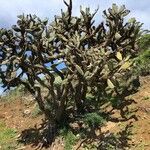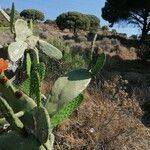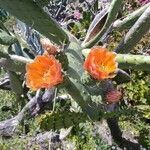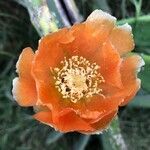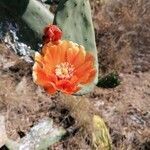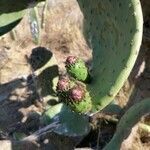Erect shrub or tree-like, to 8 m high, with main stems trunk-forming. Stem segments firmly attached, narrowly obovate, obovate to oblong, compressed, somewhat tuberculate when young, 15–30 cm long, 7–12 cm wide, green to grey-green, dull, minutely tomentose, the hairs 0.5–0.8 mm long. Areoles c. 30–40 per stem segment face, typically (18–) 20–30 mm apart, circular or subcircular, 2–2.5 mm wide, with wool greyish white. Leaves succulent, terete, conical or elongate-conical, 3–5 mm long, minutely tomentose, caducous. Spines usually absent, rarely 1 or 2 per areole (usually on younger stem segments) on occasional areoles, spreading, 3–25 mm long, 0.5–0.7 mm wide at base, terete, straight, not barbed, whitish to dirty yellow. Glochids 0.5–2.5 mm long (tend to be longer on the pericarpal), pale yellow to tan. Flowers 40–50 mm diam.; outer tepals green and tinged red in outermost series, the inner series mostly red, the minutely tomentose on outer surface, succulent, triangular (outermost series) to narrow-elliptic (inner series), the apex acute; inner tepals orange, centres often tinged red, spreading, obovate, 18–50 mm long, 12–20 mm wide, the apex obtuse and with a short mucro or acuminate, entire, or emarginate; staminal filaments pink, anthers yellow; style red, stigma lobes pale yellow to yellow; pericarpel (at anthesis) tuberculate, spineless or occasional areoles with a slender weak spine. Fruit solitary, obovoid, ellipsoid to globose, 30–50 mm long, 25–50 mm diam., tuberculate, umbilicus shallow, spineless, minutely tomentose, pink to carmine at maturity, succulent and juicy, edible. Seeds fertile, 3–5 mm long, white to pale brown.
More
A cactus. It is a small tree up to 4.5 m high. The stem segments are flattened and covered with soft velvety hair. They are 15-32 cm long and 12-16 cm wide. It can have a few spines or be spineless. The flowers are orange and have red stripes. They are 4-5.5 cm long. The fruit are oval and red. They are 3.4-5.2 cm long.
Opuntia tomentosa is predominantly naturalised in subropical, semi-arid and warmer temperate environments. It is a weed of roadsides, railways, pastures, grasslands, open woodlands, mallee, rangelands, disturbed sites and waste areas (Queensland Government 2016).
More
A tropical plant. It grows in deep soils where water is available. It suits hardiness zones 9-12.
The fruit are eaten raw or made into jams and jellies. A chutney is made by mixing the fruit with raisins, apples, onions, lemon peel, dates, sugar, vinegar and spices.
More
The fruits are edible, and produce viable seeds.
